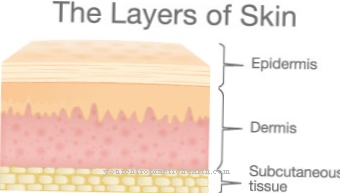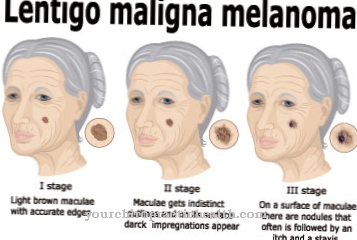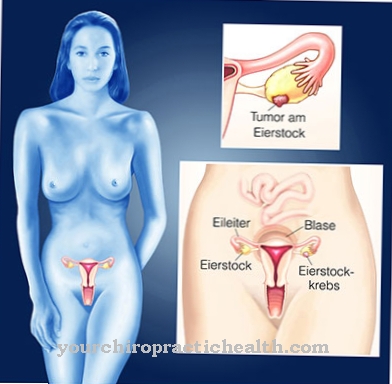The Relapsing fever is transmitted by lice or ticks that are infected with Lyme disease bacteria. The disease can usually be treated well with antibiotics, but in the event of suspicion and diagnosis, there is an obligation to report to the responsible authorities.
What is relapse fever?

© JeanPierre - stock.adobe.com
The Relapsing fever is a bacterial infection caused by Borrelia. While the disease was still widespread worldwide at the beginning of the 19th century, it is now only found in areas with very poor hygienic conditions.
There are two different types of relapsing fever: tick and lice relapsing fever. The former occurs in Central and South America, Asia and Africa as well as in Spain and Portugal. The latter mostly occurs in refugee camps or in prisons in Asia, South America and Africa. Overall, the disease can be found in tropical and subtropical areas.
The lice relapsing fever is also known as epidemic relapsing fever, the tick relapsing fever as endemic. The disease belongs to the group of borrelioses. It was discovered in 1868 by the German doctor Otto Obermeier.
causes
The Lice relapsing fever is triggered by the bacteria Borrelia recurrentis. They are transmitted to humans through lice. The pathogens can enter the body through small injuries to the skin, for example fine scratches. Injuries that are so small that humans do not even notice them are sufficient for the pathogens. Infection from person to person is not possible.
This is achieved by biting leather ticks Relapsing tick fever transfer. The pathogens here are other Borrelia species, such as Borrelia hermii. The pathogens can also get into the body through a laboratory infection or infected blood transfusions, but this only happens very rarely.
After the pathogens enter, they are distributed throughout the body via the blood and lymph vessels. They can enter different organs, stay there and continue to multiply.
Symptoms, ailments & signs
After an infection with borreliosis pathogens, the typical fever symptoms appear first: an increased body temperature, chills, pain in the limbs, muscles and head, as well as fatigue. As a result of the enlargement of the liver and spleen, jaundice occurs. The jaundice manifests itself as itching, skin changes and an increasing feeling of illness.
The typical characteristic of relapsing fever is its repetitive occurrence. After a strong fever with occasional febrile convulsions occurs in the first phase of the illness, the fever attacks subsequently weaken. In relapsing lice fever, four attacks of fever of decreasing intensity and duration usually occur.
With relapsing tick fever, up to eleven fever attacks are possible. Regardless of the trigger, the first signs of the disease appear three to four days after infection. The disease reaches its peak after 18 days at the latest. In individual cases there is a risk of severe disease with further complications. Then again and again there is clouding of consciousness and inflammation of the meninges and heart muscle.
Physically weak people run the risk of life-threatening organ failure. Externally, relapsing fever cannot be distinguished from normal fever. However, the symptoms of increased body temperature, jaundice and impaired consciousness indicate a serious infection that urgently needs to be clarified.
Diagnosis & course
A first hint at that Relapsing fever deliver recurring fever attacks lasting three to seven days. A final diagnosis is made through a blood test using a microscope. However, the Borrelia can only be seen in the blood during the fever attacks.
The fever-free phases become longer after each fever attack, the fever attacks become shorter and lighter. With relapsing lice fever, four fever attacks are normal, with tick relapsing fever up to eleven repetitions can occur. Accompanying symptoms are headache and body aches, a rash the size of a pinhead, chills and jaundice. Often the spleen and liver also enlarge. The first symptoms appear around four to 18 days after infection.
Possible complications are impaired consciousness and, in the worst case, inflammation of the meninges, the brain or the heart. Liver failure or multiple organ failure can also be serious complications.
Complications
As a rule, relapsing fever can be treated relatively well, so that the complications only arise if the disease is not treated. Those affected suffer from a high fever and the usual symptoms of flu or a cold. This leads to severe head pain and pain in the limbs.
In the further course of the disease, jaundice can also develop, which is accompanied by chills. Those affected also suffer from a skin rash associated with itching due to the disease. If the person concerned scratches himself frequently, this can lead to the formation of scars. The liver and spleen are also enlarged in relapsing fever, so that pain may occur in these regions. Furthermore, the disease can lead to inflammation in the brain, which can irreversibly damage the brain.
As a rule, relapsing fever can be treated easily and without complications. However, the person affected should be isolated from other people. Successful treatment does not result in a reduced life expectancy for the person affected. In serious cases, relapsing fever can also lead to circulatory shock, so that the person concerned is dependent on an inpatient stay in the hospital.
When should you go to the doctor?
Relapsing fever should always be treated by a doctor. This condition can have serious complications if the condition is not treated properly. A doctor should be seen if the person has a very high fever. The usual ailments and symptoms of flu or a cold also occur, which have a very negative effect on the quality of life of the person concerned.
It also causes severe itching and, in some cases, jaundice. The relapsing fever can also enlarge the liver and spleen. People may have disorders of consciousness or even heart problems.
If these symptoms occur, a doctor should be consulted immediately. Relapsing fever can be diagnosed by a general practitioner or in a hospital. With further treatment there are usually no complications.
Treatment & Therapy
Both forms of the Relapsing fever are treated with antibiotics, tetracycline and doxycycline have proven effective. The drugs are taken for about a week. The person concerned may be isolated from other people. Without adequate treatment, relapsing fever can lead to death.
When antibiotics are given, a so-called Jarisch-Herxheimer reaction can occur. After eliminating many bacteria at once, the organism releases the body's own substances that initiate inflammatory reactions in the body. These so-called "inflammation mediators" include, for example, histamine and serotonin. Symptoms of a Jarisch-Herxheimer reaction are high fever, nausea, headache, joint and muscle pain and skin rashes, i.e. symptoms that are very similar to those of relapsing fever.
Most of the time, these increased symptoms only last a few hours, but they can last for several days. In particularly severe, rare cases, circulatory shock can occur. In order to prevent this reaction or at least to weaken it, glucocorticoids are administered before the antibiotic is administered, i.e. certain hormones which, in their natural function, influence the sugar metabolism.
prevention
Against that Relapsing fever there is currently no vaccine. As a precautionary measure, areas with poor hygiene standards should be avoided, for example unclean hotels. To protect yourself against tick bites, you should wear clothing with long sleeves and legs, socks and sturdy shoes. Insect repellants, available as a lotion or spray, are also a good preventative measure. In the areas where lice relapse fever is common, the species of lice that the pathogen can transmit are combated.
Aftercare
Such an infection is very stressful for the body of the patient concerned, especially if antibiotic therapy could not be started immediately. Therefore, the patient is still in convalescence, even if symptoms such as fever or itching no longer appear. For those affected, this means that they should continue to take care of themselves during the follow-up period.
The body's immune system has to be rebuilt. This is best done through extended rest periods and a healthy, fresh diet that is prepared daily and contains many vitamins, minerals and fiber. Because eighty percent of all immune cells are in the intestine, the administration of probiotics can be considered. Appropriate dietary supplements are available in pharmacies or drugstores without a prescription.
They contain living microorganisms (mostly lactic acid bacterial cultures) that implant and multiply in the intestine and thus ensure a healthy immune system. Almost as important as bowel hygiene, exercise has an effect on building the immune system. A lot of exercise regulates the metabolism and stimulates the heart, circulation and the immune system.
If the patients suffered from extensive rashes with a relapsing fever, intensive skin care is recommended in these areas. Depending on the extent of the remaining symptoms, the skin needs to be re-supplied with fat and / or moisture. In some cases, scar treatment with appropriate oils is also recommended.
You can do that yourself
To protect against infection, the person concerned should take special care in everyday life. Since the pathogens can start from one person to the next even with minor injuries, particular care must be taken with open wounds that no transmission can take place. It is a reportable disease that is highly contagious.
In addition to preventive measures, the possibilities for self-help are limited to strengthening the body's own defense system. So that the organism is supported in the healing process as best as possible, a healthy and balanced diet is important. A vitamin-rich diet strengthens the immune system and promotes recovery. The symptoms of relapsing fever include an increased body temperature. The symptoms can be relieved with cold compresses and adequate hydration. The sick person needs an adequate supply of oxygen. Therefore, the premises should be ventilated as well as possible at regular intervals. In addition, sleep hygiene must be optimized and adapted to natural needs.
Overexertion, stress or additional strain should be kept away from the patient. Physical activities are to be reduced to a minimum. Otherwise, these can lead to complications and further deterioration in health. If itching is present, particular attention must be paid to the possible risk of infection. If possible, avoid scratching.





.jpg)
.jpg)

















.jpg)



